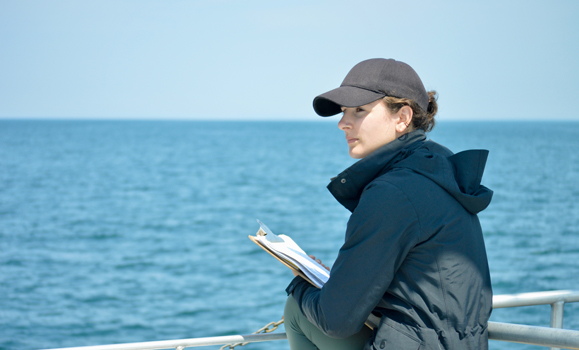Every summer students registered in a Faculty of Science SEASIDE course know theyтАЩre going to get their hands wet with experience studying the ocean and its life.
This past summerтАЩs Field Studies of Marine Mammals SEASIDE course was no different, but this year it was expanded to accommodate 15 international students interested in having a unique Atlantic Canadian experience learning marine biology.
тАЬA lot of ║┌┴╧│╘╣╧═Їfaculty and staff came together to create a special learning experience for students from all over the world,тАЭ said Cindy Staicer, the SEASIDE Program Director. ┬атАЬFunding from The Schulich Ocean Studies Initiative via the Schulich Foundation, DalhousieтАЩs Provost and Vice-President Academic, and the Office of International Relations helped us do that.тАЭ

A humpback whale breaches
The field course brought together students from Norway, Sweden, Israel and Canada. Over three weeks, students attended lectures and workshops to learn the ropes of what theyтАЩd be seeing and doing during a five-day marine biology field trip to the Bay of Fundy region of Nova Scotia, known for its exceptional whale watching opportunities.
While tourists go to marvel at the beauty of whales, SEASIDE students went to work in groups to collect data on marine mammals for a research project due at the end of the course. Marvelling at the beauty of whales just came with the territory.
 тАЬIt felt like so much more than three weeks because we did a million different things,тАЭ said Karoline Viberg, a visiting student from the University of Bergen in Norway (pictured left). тАЬA lot of our workshops covered things you would do if you had a job. I really liked the lectures too but going into the field was the highlight.тАЭ
тАЬIt felt like so much more than three weeks because we did a million different things,тАЭ said Karoline Viberg, a visiting student from the University of Bergen in Norway (pictured left). тАЬA lot of our workshops covered things you would do if you had a job. I really liked the lectures too but going into the field was the highlight.тАЭ
A wealth of wildlife
Viberg had seen humpback whales before but the experience she had in Nova Scotia was one sheтАЩll never forget.
тАЬIтАЩve never seen humpbacks that close,тАЭ she said. тАЬIтАЩve never seen each and every baleen in their mouth!тАЭ
 Tom Haran (pictured right), a student visiting from The Hebrew University of Jerusalem, shared KarolineтАЩs enthusiasm.
Tom Haran (pictured right), a student visiting from The Hebrew University of Jerusalem, shared KarolineтАЩs enthusiasm.
тАЬThis was an amazing experience. We saw an exceptional amount of wildlife this trip. Tons of whales, dolphins, seabirds, seals,тАЭ said Haran. тАЬItтАЩs a very good thing to be outside of the classroom and on a boat. ThatтАЩs not something I usually do back home.тАЭ
A global effort
For ║┌┴╧│╘╣╧═Їmarine biology student Laura Raposo, the Field Studies of Marine Mammals course highlighted the commitment and passion that those teaching it brought to their lesson plans.

тАЬTheir love for and experience with the topic truly deepened my knowledge about marine mammals and sparked a greater passion in me to pursue research,тАЭ said Raposo, whoтАЩs currently in her third year.
Damian Lidgard was one of the instructors. For him, bringing students from both sides of the Atlantic Ocean together was one of the most thrilling aspects of teaching this course.
тАЬIt was very gratifying to be able to work with students from other countries and provide them with the opportunity to work with some of the remarkable marine mammal life that Canada is fortunate to have,тАЭ said Dr. Lidgard, a part-time academic with the Department of Biology. тАЬIt was especially rewarding to see how the international and Canadian students worked together as a team to tackle their research assignments.тАЭ
Working in groups allowed all students to tap into the unique knowledge and experience a class of people with an тАЬarray of nationalities, ages and gender,тАЭ has to offer, explained Raposo.
тАЬResearch and conservation efforts in area of ocean sciences will only succeed with the teamwork of scientists from around the globe,тАЭ said Raposo. тАЬThis is why classes that allow students to learn alongside their international peers are so important in giving students the proper tools to be able to work together to solve problems concerning the ocean.тАЭ

